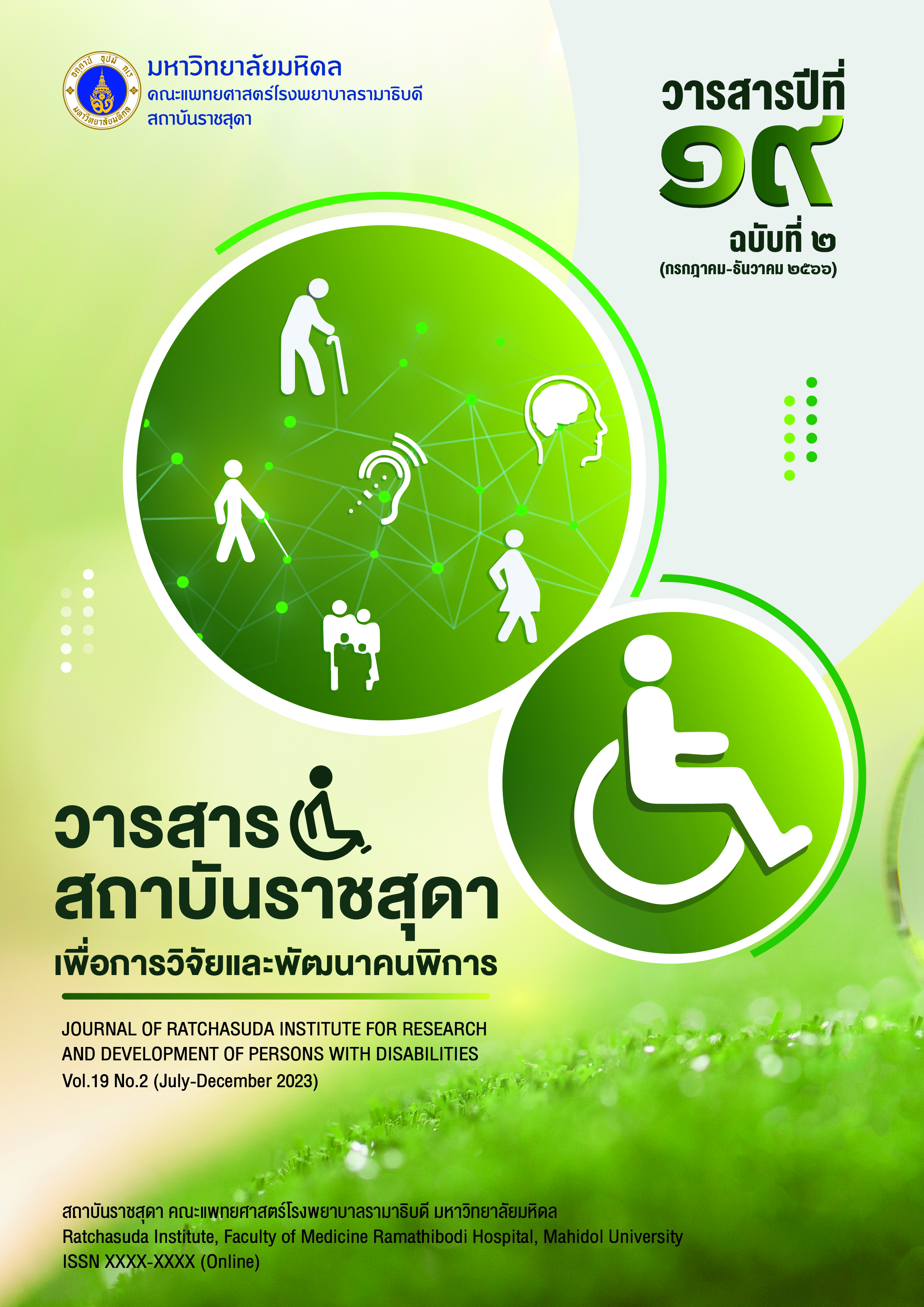Digital Technology for Learners with Disabilities
Keywords:
Digital Technology, Learning of Children with Disabilities, Children with DisabilitiesAbstract
Thailand has adopted an Act on Promotion and Development of the Quality of Life of Persons with Disabilities (No. 2), B.E. 2556. (Empowerment of persons with disabilities act, B.E. 2550 (2007) and amendment (No. 2), B.E. 2556 (2013), 2013) and the Education for Persons with Disabilities Act, B.E. 2551 (Education provision for persons with disabilities act, B.E. 2551 (2008), 2008). Statutes that are used as guidelines for promoting and developing human resources in many dimensions, These, give the rights of children with disabilities in medical care, educational opportunities, social participations and work. The Ministry of Education has a policy to promote learning for children with disabilities to receive the same educational management as children without disabilities. Moreover, the ministry of education provides children with disabilities the rights to receive educational assistance services since the first found disabilities or at birth with disabilities. In addition, children with disabilities will also receive media, and educational facilities and services which are specified in the Education for Persons with Disabilities Act. Therefore, the promote of learning for children with disabilities should be aware of the appropriateness in many dimensions. The media and facilities that will be provided for children have to the acceptance and consent from parents of children with disabilities. The children with disabilities should be served based on their willingness and their beneficial. Joy Smiley Zabala (Zabala, 2021) who specializes in the management of special education in the United States of America. suggested implementation of SETT Framework. This frame work is a Framework for creating medias that is focused on child-centered concept. The SETT Framework has four principles that should be considered: Student (S) refers to the characteristics of a student, Environment (E) in which the student learns and do any activity, Tasks (T) required to tasks or activities arranged for children to do, and Tools (T) refers to tools that enables the student to actively engage in the tasks in the environments.
Downloads
References
Arayawinyoo, Ph. (1999). Education for children with special needs. Wankaw Publishing House.
Arayawinyoo, Ph. (2001). Children with learning difficulties. Wankaw Publishing House.
Constitution of the Kingdom of Thailand. (2019). Government Gazette. No.134 Section 40A. page 1-90.
Chonlatarnon, B. (2003). Handbook of joint learning management by using the SEAT structure. Teachers Council of Thailand Printing House, Faculty of Education Suan Dusit Teachers College.
Da Fonte, A., Boesch, M. C., Dodd, R. E., Bennett, B. P., & Edwards-Bowyer, M. E. (2016). The SETT framework: SETTing the classroom for communication success. DADD Online, 3(1), 108-122.
Education provision for persons with disabilities act, B.E. 2551 (2008). (2008) Government Gazette. No. 125 Section 28A. page 1-13.
Empowerment of persons with disabilities act, B.E. 2550 (2007) and amendment (No. 2), B.E. 2556. (2013). (2013). Government Gazette. No. 130 Section 30A. page 6-12.
Hongngam, K., Inchampa, D., & Chanapai, K. (2021). The digital technology easy to read books in learning support for children with disabilities. In the Bureau of Special Education Administration (Ed.), Designed technology in closing education gaps. Proceedings of the 9thInternational Conference on Special Education of Bureau of Special Education Administration (pp. 1-10), Thailand.
Hongngam, K., & Polrachom, S. (2021). The developmental package for promoting development of children with dyslexia in early stage. Journal of Ratchasuda College for Research and Development of Persons with Disabilities, 17(1), 4-18.
Inthanon, S. (2020). DQ digital intelligence. Children and Youth Media Promotion Foundation.
Jutrakul. S. (2016). Digital literacy, digital natives and family. Journal of Management Science Chiangrai Rajabhat University, 11(1), 131-150.
Kirdthai, N. (2010). Use of computer-assisted instruction and intellikeys to develop concept mapping skill of a student with cerebral palsy. Chiang Mai University.
Ministry of Digital Economy and Society. (2016). Thailand digital economy and society. Ministry of Digital Economy and Society.
National Education Act B.E.2562 (2019) (No.4). (2019). Government Gazette. No. 136 Section 57A. page 49-53.
Office of National Digital Economy and Society Commission. (2021). Applications for access to people with disabilities. Thailand: Office of National Digital Economy and Society Commission.
Office of the Secretariat of the Teachers Council of Thailand. (2012). Research Report on Professional Standards of Special Education Teachers in Bangkok. Bonus Prepress Co., Ltd.
Rattanathrun, Ph. (2018). Instructional Designing Inventory using 21st multimedia for Developing Scientific Conceptual and Scientific Attitudes through Secondary Students at the 11th Grade. Rajabhat Maha Sarakham University.
Tammasang, M. (2011). Education for hearing impaired children in Thailand. Foundation for the Deaf Thai under the Royal Patronage.
Thai Autism Foundation. (2013). Autism application. Thai Autism Foundation.
Zabala, J. S. (2005). Ready, SETT, go! Getting started with the SETT framework. Closing the Gap, 23(6), 1-3.
Zabala, J. S. (2021). SETT Framework. TTAC online. https://ttaconline.org/Resource/JWHaEa5BS762YneJq2Re3Q/Resource-sett-Framework-joy-Zabala, J.
Zabala, J. S. & Carson, J. (2021). ISET Expert Panel Discussion: SETT and AT Evaluation Done Remotely [Video]. https://www.youtube.com/watch?v=GkvK6Junskc&list=PLdAALw6w14Jd6MhDXdlb6_HnCibt9EBL0
Downloads
Published
How to Cite
Issue
Section
License
Copyright (c) 2023 Journal Of Ratchasuda Institute for Research and Development of Persons With Disabilities

This work is licensed under a Creative Commons Attribution-NonCommercial-NoDerivatives 4.0 International License.
บทความที่ได้รับการตีพิมพ์เป็นลิขสิทธิ์ของวารสารสถาบันราชสุดาเพื่อการวิจัยและพัฒนาคนพิการ






